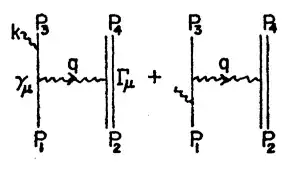In this paper (relevant pdf section) that I'm reading, involving the calculation of bremsstrahlung in electron proton scattering (diagram below), the author calculates the integral over outgoing photons and scattered electron: $$\tag{III.10} A=\int d\Omega\int_{E_\text{3,min}}^{E_\text{3,max}}p_3 dE_3 \frac{\sqrt{(kt)^2-\lambda^2t^2}}{2t^2} \theta(E_4) \int {d\tilde\Omega_k} \chi^2$$
The integral is transformed from an integral over $E_3$ to one over $x\equiv t^2-M^2$, which leads to (up to order $\lambda^2$):
$$A=\int d\Omega\int_{x_\text{min}}^{x_\text{max}}\color{blue} {\frac{p_3}{4M \eta}}\cdot \frac{x dx}{2(x+M^2)} \int {d\tilde\Omega_k} \chi^2$$
Instead, the author somehow pulls $p_3$ outside of the integral, and gets: $$\tag{III.13} A=\int d\Omega \color{blue}{\frac{E_3}{4M \eta}}\int_{x_\text{min}}^{x_\text{max}} \frac{x dx}{2(x+M^2)} \int {d\tilde\Omega_k} \chi^2$$
The author then proceeds to use this expression to compare to the famous Rosenbluth formula, and now the "problem" $E_3$ disappears entirely:
$$\tag{III.18}\left(\frac{d\sigma}{d\Omega}\right)_\text{brem}=-\left(\frac{d\sigma}{d\Omega}\right)_\text{Rosenbluth} \times \frac{\alpha}{8\pi^2}\int_{x_\text{min}}^{x_\text{max}} \frac{x dx}{2(x+M^2)} \int {d\tilde\Omega_k} \chi^2$$
My Questions:
What justifies the pulling out of $E_3$ from the integration, when $x$ is clearly a function of $E_3$?
Where did the factor $E_3/M\eta$ in $\text{III.13}$ disappear to when comparing the cross sections?
I suspect the answers to these two questions are related, but I can't seem to see how this can be correct.
$\quad\quad\quad\quad\quad\quad\quad\quad$